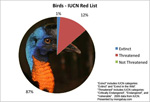Scientists have announced that freshwater species are likely the most threatened on earth. Extinction rates for freshwater inhabitants are currently four to six times the rates for terrestrial and marine species. Yet, these figures have not led to action on the ground.
“Few are aware of the catastrophic decline in freshwater biodiversity at both local and global scale. Threats to freshwater biodiversity have now grown to a global scale,” says Klement Tockner of the Leibniz-Institute of Freshwater Ecology and Inland Fisheries, Berlin.
Freshwater species provide key services for humans; their loss affects the availability of clean water, disease regulation, and subsistence agriculture and fishing. These species are also important carbon sequesters: freshwater ecosystems and species absorb and bury about 7 percent of the annual carbon added to the atmosphere every year, according to Tockner.
“Despite their pivotal ecological and economic importance, freshwater ecosystems have not been of primary concern in policy making,” Tockner says. “Only recently did the European Union take the initiative to improve this situation through the EC Biodiversity Strategy. And in the U.S., recent Supreme Court decisions have made wetlands and small streams more vulnerable to loss.”
Threats are only expected to worsen for freshwater species as human consumption of freshwater continues to expand—exceeding limits in many parts of the world—and climate change causes more and longer droughts.
“The pace of extinctions is quickening,” warns Tockner, “especially in hot spot areas around the Mediterranean, in Central America, China and throughout Southeast Asia.”
Related articles
Save the frogs, save ourselves

(09/04/2009) Amphibians are going extinct around the globe. As a scientist specializing in frogs, I have watched dozens of species of these creatures die out. The extinction of frogs and salamanders might seem unimportant, but the reality couldn’t be farther from the truth. Indeed, from regulating their local ecosystems, to consuming and controlling the population of mosquitoes and other insects that spread disease, to potentially pointing the way to new drugs for fighting diseases such as cancer or HIV-AIDS, the fate of these creatures is inexorably linked to our own.
869 species extinct, 17,000 threatened with extinction

(07/02/2009) Nearly 17,000 plant and animal species are known to be threatened with extinction, while more than 800 have disappeared over the past 500 years, reports the International Union for Conservation of Nature (IUCN). While these numbers are substantial, they are likely “gross” underestimates since only 2.7 percent of 1.8 million described species have been assessed. The IUCN report warns that governments will miss their 2010 target for reducing biodiversity loss.
New Yangtze River dam could doom more endangered species
(06/22/2009) Eight Chinese environmentalists and scientists have composed a letter warning that a new dam under consideration for the Yangtze River could lead to the extinction of several endangered species. The letter contends that Xiaonanhia Dam, which would be 30 kilometers upstream from the city of Chongqing, will negatively impact the river’s only fish reserve. Spanning 400 kilometers in the upper Yangtze, the reserve is home to 180 fish species, including the Endangered Chinese sturgeon, and the Critically Endangered Chinese paddlefish, as well as the finless porpoise.